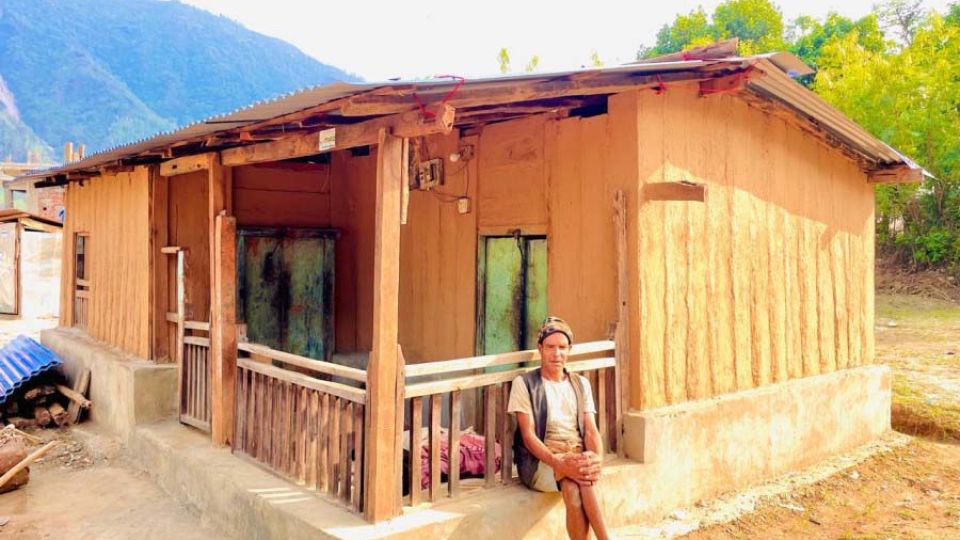July 30, 2024
KATHMANDU – At least 140 people have died and 2,268 families have been affected by floods and landslides since the June 10 onset of the monsoon this year.
Among the affected families, hundreds have been displaced from their homes. Owing to the government’s apathy, those who have been taking refuge in schools, community homes and in barns of the neighbours and relatives have been deprived of immediate relief money to build temporary shelters.
“We don’t have the budget even to provide an immediate relief amount to those displaced in various disasters,” said Anil Pokhrel, chief executive officer of the National Disaster Risk Reduction and Management Authority (NDRRMA). “Hundreds of families are still waiting for relief money so that they can build makeshift shelters.”
Living in schools, community homes and cattle sheds for a long time is not easy. School administrations often ask the displaced people to vacate, as their presence disrupts regular classes. Officials concede that displaced people make daily rounds of the local authorities and homes of elected representatives, hoping to get the first tranche of relief amounts, but they return disappointed.
“We have asked for Rs250 million to provide immediate relief to the displaced, so that they can start building temporary shelters, but the Ministry of Finance has released only Rs30 million. This is insufficient to meet the needs of hundreds of victims,” said an official at the authority, asking not to be named, as he is not authorised to speak to the media.
Officials admit that the authority is unable to release relief money not only for those displaced during the ongoing monsoon, but also for the victims of the rain-related disasters from 2020.
They say the number of disaster victims, who have been waiting for relief amounts, is in the thousands.
“There are over 1,700 displaced families in our district,” said Rabiraj Dhital, Information officer at District Administration Office, Sindhupalchok. “Of the total number of displaced, around 1,000 have received the first tranche to begin building houses, and 400 have received the second tranche. The reality is that most victims’ homes remain unfinished due to the authorities’ failure to offer timely relief, leaving them in pitiable conditions.”
The government has decided to provide Rs550,000 to the disaster victims. Of this amount, 15 percent will come from the respective local units, 30 percent from the provincial government, and 55 percent from the federal government.
“Had the federal and provincial government agencies told us that they would not provide anything, we would have made a decision on the relief amount ourselves,” said Aitaman Tamang, chairman of Melamchi Municipality. “Every day, displaced people come to my office and even to my home asking for relief, but I can’t make any decisions.”
Officials at the NDRRMA said that the delay by the Cabinet in approving recent changes in relief-related guidelines is the main reason displaced people haven’t received relief money.
“Those displaced by the Jajarkot earthquakes got Rs50,000 in immediate relief to start building temporary shelters,” said chief executive officer Pokhrel. “The guidelines’s approval would allow similar support for families affected by other disasters, particularly floods, fire, and landslides.”
Pokhrel said that the guidelines have now been submitted for the Cabinet’s approval, and once approved, the authority will be able to provide similar support to families affected by floods and landslides.
Nepal is highly vulnerable to natural disasters like earthquakes, landslides and floods. The country, however, struggles to effectively manage large-scale disasters, experts say. They say the reactive approach of the authorities concerned is responsible for the loss of lives and property.
The Department of Hydrology and Meteorology has forecast above-normal rains and above-average temperatures the monsoon, which could unleash extreme weather events such as flooding, inundation, and landslides.
Several districts have already experienced incidents of landslides, floods and lightning since the monsoon season began.
According to the National Disaster Risk Reduction and Management Authority, at least 1,140 people have died, while 120 others are missing due to landslides, floods, and lightning since June 10.
Officials at the authority said 86 people—41 males and 40 females—have been killed in landslides, 26 in floods—11 males and 15 females—and 23 more in lightning strikes.
Nepal is one of the world’s most vulnerable countries to the climate crisis and has witnessed multiple extreme weather events over the past decade and a half.
Evidence suggests that maximum temperatures in Nepal are rising faster, at 0.056 degrees Celsius a year, compared to the global average rise of 0.03 degrees.
Experts say extreme weather events—excessive rainfall in a short period, continuous rains for several days after the monsoon, dry spells, droughts, below-average precipitation, and above-normal winter temperatures—have become more frequent in Nepal.
The NDRRMA estimates that 1.81 million people and 412,000 households will be affected by monsoon this year. Of them, 83,000 households will be directly hit, and 18,000 families will require rescue from monsoon-related disasters.


